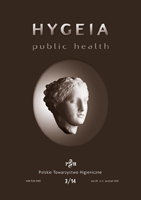Home page |
Editorial Board |
Editor |
Subscription |
Infomation for authors |
Conferences |
Partners

|
|
|
ISSN 1509-1945
 
 
  search by |
Hygeia Public Health 2017, 52(2): 151-156pl
 Manual therapy for a scar after cesarean sectionMałgorzata Chochowska 1,2,3/, Jerzy T. Marcinkowski 4/, Aneta Klimberg 4/ 1/ Centrum Fizjoterapii i Terapii Manualnej KORE 2/ Zakład Rehabilitacji, Zamiejscowy Wydział Kultury Fizycznej, Akademia Wychowania Fizycznego im. Eugeniusza Piaseckiego w Poznaniu 3/ Pracownia Terapii Manualnej i Masażu, Wyższa Szkoła Edukacji i Terapii w Poznaniu 4/ Katedra Medycyny Społecznej, Uniwersytet Medyczny im. Karola Marcinkowskiego w Poznaniu Summary Currently in Poland about 40% of pregnancies are resolved by a caesarean section (CS), leaving a scar that will require a targeted treatment to restore proper mobility and separation from surrounding tissues and prevent adhesions within the healing tissues. A serious problem are post-CS adhesions, ranging from 46 to 100% in various estimates and growing with each subsequent CS, which may be the source of non-specific gastrointestinal, urinary and reproductive ailments. They can also cause chronic pelvic pain or obstruction connected with the so-called "narrow intestine", dyspareunia or infertility. The patient generally does not associate the ailments with the CS scar. Direct and indirect techniques in manual therapy are effective and safe forms of conservative work with scarring after CS, mainly: lymphatic drainage, muscular and fascial loosening and deep massage, supplemented with auto-therapy. Key words: caesarean section, scar, adhesions, conservative treatment |


